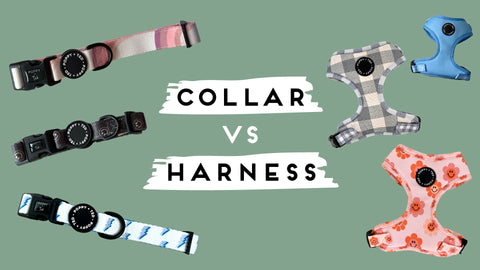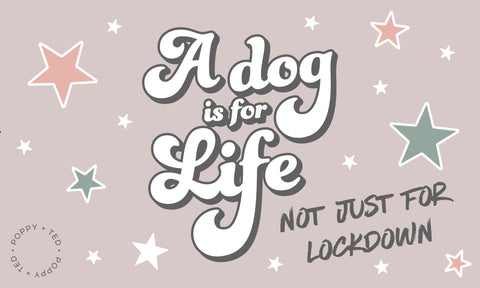It can be tricky deciding between a collar or a harness for your dog. There are many deciding factors when it comes to which is the safest and all-around best option for your dog. In this post, we will explain the pro’s and cons of both and help you make an informed decision for your furry friend.

Pros of Harnesses
They Relieve Pressure On Your Dogs Neck
Depending on the breed, dogs can often be stronger than their owners. This means that dogs can pull their owner on walks rather than them walking closely on the lead. A collar sits around the dog's neck, so when they pull, it can create tension and puts pressure on the trachea, which can cause discomfort and breathing difficulties. Whilst we would highly recommend correcting pulling from the get go of teaching your dog to walk to heal, harnesses can also be a great tool to help. Harnesses sit a little further down across the main chest of the dog, opposed to the top of the neck and trachea area. This is particularly great for dogs who have neck problems or restricted airways and can help prevent these issues from arising in the future.
Offers you more control
Dogs can pull for several reasons, including behavioural problems, over-excitement, excess energy or their size compared to their owner. When they’re walking with a collar and lead and start to pull, it can cause tension and tightness around their neck, which can cause damage to their trachea. Harnesses cover a much larger surface area, including their strongest point, the chest, shoulders and upper back, which gives the owner better control of the dog without causing pain.
They Tend To Be More Secure
A harness secures the dog in multiple places, including around its chest, front legs, and back, allowing for much less wiggle room and the chance of escape. With our adjustable harnesses, your can adjust the fit for your dog at both the neck as well as the chest for a more personalised fit as we understand dogs come in all shapes and sizes (even the same breed)!
Cons Of Harnesses
They May Not Have Space For An ID Tag
Often some harnesses come with an attachment for the lead only and don’t have room for an ID tag. An ID tag is a must-have for any pet to wear at all times, even when they’re at home. If your dog were to escape or get lost, it’s the easiest way to identify they have an owner and are not a stray. The ID tag should include the owner's name and contact number at a minimum. At Poppy + Ted we offer an alternative to the traditional hanging keyring style ID tag which are great for harnesses. Available in 3 different widths you can slide and secure your tag onto the side chest strap so you know this isn’t going to fall off or get caught and/or lost whilst on a walk so that should the worst happen, you will be reunited with your four-legged friend as soon as possible.
They Can Be Bulky
Because harnesses are a lot bigger than collars and require more material, they tend to be a lot bulkier and heavier, defeating the purpose of being comfier than a collar. If you’ve decided on a harness over a collar, most dogs wear them most of the time, just like their collars! That’s why it’s important to choose one that's comfortable and lightweight but still protects.
At Poppy and Ted, we have developed a range of ‘walk + wear’ harnesses that are designed to be worn for extended periods of time. They are made from durable polyester and have our lightweight signature breathable and padded mesh lining so your dog doesn’t skimp on comfort or style! (They’re machine washable and quick drying too.)
They Can Be Uncomfortable In Warmer Weather
Often if something is bulky, it can be uncomfortable in warm weather. If you decide for your dog to wear a harness, you want them to be able to wear them all year round and not have to switch to a collar in the summer months. When you choose your harness, make sure it’s made from breathable fabric so that your dog is comfortable. The last thing you want is for your dog to overheat from wearing a thick harness.
When Is A Harness Your Best Option?

There are a few situations where a harness should definitely be chosen over a collar for your dog. For example, if your dog is a brachycephalic breed. These dogs typically have flatter faces and often struggle with respiratory issues. Their breathing can be better regulated with a harness than a collar as it distributes the tension. Bulldog breeds, Pugs and Shih Tzus are just a few examples of brachycephalic breeds.
In some dogs, there is a condition known as tracheal collapse, where the trachea can fold in on itself, causing breathing trouble and a cough. If your dog has this or is at risk of developing this, a collar can actually worsen the condition. Therefore, it’s safer to choose a harness in this case.
Pros Of Collars
They're Typically More Convenient
Collars are universally designed to be kept on the dog at all times, so you can easily clip their lead on when going for walks. Most dog owners choose not to keep a dog's harness on throughout the day, so it can be an annoyance to clip on and off when out for walks or playing in the garden.
They’re Designed To Hold ID Tags
Collars are more common than harnesses, so they have been designed and adapted to meet the needs of dogs and their owners. All collars are designed with a metal ring to attach an ID tag as well as your lead to make sure your dog can be identified and found should they go missing and not be confused with a stray dog.
In addition if your dog is sensitive to noise, or you prefer something that doesn’t jangle around, at Poppy + Ted we also offer slide ID Tags which are available in 3 different widths depending on the size of your collar. These can easily be attached to your collar full to ensure your dog can always be identified to find it’s way back to you.
They are lightweight and comfortable
As something your dog is going to wear daily in all weathers, it’s important you choose something comfortable as well as cute. Because like we say, who said essential had to mean boring? We’re passionate about creating essential pieces for your dog that are both practical and comfortable as well as stylish so with our soft padded collars made from durable polyester they’re equally soft, sturdy and light weight. Extra bonus? They’re machine washable and quick drying too!
Cons Of Collars
They’re Not Safe For All Dog Breeds
Some dogs are more prone to specific medical issues than others, which means collars aren’t always the safest option. If your dog suffers from glaucoma, neck injuries or spinal malformations, or are a brachycephalic breed you should maybe think about choosing a harness over a collar. We recommend consulting with your vet before choosing a collar to ensure they’re healthy enough!
They’re Dangerous For Dogs That Tend To Pull
If your dog tends to pull against their collar, they can injure themselves or limit the airflow they’re getting. They may pull due to behavioural issues, getting overly excited or because their size is larger than their owners. A harness spreads the tension across the neck, back and chest to reduce the feeling of pulling on the lead and cause less damage over time.
When Is A Collar Your Best Option?

A collar can be more convenient for dog walkers, so if you’re going on a short walk or stepping outside quickly, a collar offers enough protection. You can choose to use a collar on longer walks, but we recommend consulting your vet beforehand if you’re concerned.
Ultimately, the decision of harness or collar is up to you. We recommend thoroughly researching your dog's behavioural characteristics and any health issues they’re prone to. At Poppy and Ted, we stock a range of both harnesses and collars in different sizes, patterns and materials for your choosing. Get in touch for more information on your dog's safety and how we can help!



